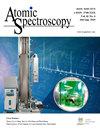High-Precision Fe Isotope Analysis On MC-ICPMS Using A 57Fe-58Fe Double Spike Technique
IF 2.3
2区 化学
Q1 SPECTROSCOPY
引用次数: 1
Abstract
Herein we report procedures based on multi-collector inductively coupled plasma mass spectrometry (MC-ICPMS) for high-precision Fe isotopic analysis using a 57Fe-58Fe double spike technique. Iron purification was achieved using AG1-X8 in HCl media following previously or newly established procedures. In the new procedure, smaller columns with 4 mm diameter were used, containing 0.4 mL AG1-X8, thus greatly reducing the operation time and the amount of acid and resin consumed compared to the previously established method using 1 mL resin. Potential trace Ni interference on 58Fe was suppressed by increasing the total Fe ion intensity to ≥ 120 V. Measurements of GSB Fe solutions doped with mono-elements demonstrated that a mass bias correction by the 57Fe-58Fe double spike was robust if Ca/Fe ≤ 1.0, Al/Fe ≤ 1.0, Cu/Fe ≤ 1.0, Co/Fe ≤ 0.1, Ni/Fe ≤ 10-4, and Cr/Fe ≤ 10-4. Monitoring of pure Fe standard solutions, viz. IRMM-014 and NIST3126a, and geological reference materials, viz. JP-1, BHVO-2, W-2a, GSP-2, and COQ-1, over nine months yielded δ56Fe (relative to IRMM-014) values of 0.003 ± 0.013‰ (2 SD, N = 20), 0.368 ± 0.011‰ (2 SD, N = 30), 0.019 ± 0.018‰ (2 SD, N = 15), 0.109 ± 0.017‰ (2 SD, N = 30), 0.049 ± 0.018‰ (2 SD, N = 17), 0.155 ± 0.018‰ (2 SD, N = 14), and -0.066 ± 0.022‰ (2 SD, N = 20), respectively, consistent with the recommended values within quoted errors. Based on repeated analyses of the standards, the long-term precision of our double spike method is better than 0.02‰ for δ56Fe on average, proving its ability to distinguish small isotope fractionation among high-temperature samples.用57Fe-58Fe双尖峰技术在MC-ICPMS上进行高精度Fe同位素分析
在此,我们报道了基于多收集器电感耦合等离子体质谱(MC-ICPMS)的程序,使用57Fe-58Fe双尖峰技术进行高精度Fe同位素分析。按照先前或新建立的程序,在HCl介质中使用AG1-X8实现铁纯化。在新程序中,使用直径为4mm的较小柱,包含0.4mL AG1-X8,因此与先前建立的使用1mL树脂的方法相比,大大减少了操作时间以及酸和树脂的消耗量。通过将总铁离子强度增加到≥120V,可以抑制58Fe上潜在的痕量镍干扰。对掺杂有单元素的GSB-Fe溶液的测量表明,如果Ca/Fe≤1.0、Al/Fe≤1.0Cu/Fe≤1.0%、Co/Fe≤0.1、Ni/Fe≤10-4和Cr/Fe≤10-4,则57Fe-58Fe双尖峰的质量偏置校正是稳健的。对纯铁标准溶液,即IRMM-014和NIST3126a,以及地质参考材料,即JP-1、BHVO-2、W-2a、GSP-2和COQ-1进行监测,超过9个月,得出δ56Fe(相对于IRMM-0114)值为0.003±0.013‰(2 SD,N=20)、0.368±0.011‰(2 SD卡,N=30)、0.019±0.018‰,0.155±0.018‰(2 SD,N=14)和-0.066±0.022‰(2 SD卡,N=20),与引用误差内的推荐值一致。通过对标准品的反复分析,我们的双尖峰方法对δ56Fe的长期精度平均优于0.02‰,证明了它能够区分高温样品中的小同位素分馏。
本文章由计算机程序翻译,如有差异,请以英文原文为准。
求助全文
约1分钟内获得全文
求助全文
来源期刊

Atomic Spectroscopy
物理-光谱学
CiteScore
5.30
自引率
14.70%
发文量
42
审稿时长
4.5 months
期刊介绍:
The ATOMIC SPECTROSCOPY is a peer-reviewed international journal started in 1962 by Dr. Walter Slavin and now is published by Atomic Spectroscopy Press Limited (ASPL). It is intended for the rapid publication of both original articles and review articles in the fields of AAS, AFS, ICP-OES, ICP-MS, GD-MS, TIMS, SIMS, AMS, LIBS, XRF and related techniques. Manuscripts dealing with (i) instrumentation & fundamentals, (ii) methodology development & applications, and (iii) standard reference materials (SRMs) development can be submitted for publication.
 求助内容:
求助内容: 应助结果提醒方式:
应助结果提醒方式:


